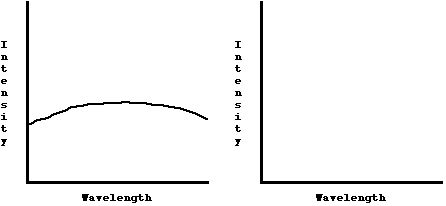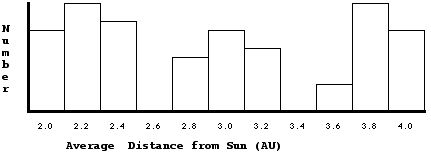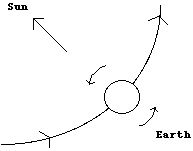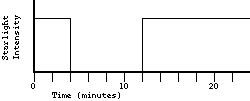In the past few decades, Astronomers have discovered that Pluto sometimes has a thin atmosphere (when it is close enough to the Sun for some of the material on its surface to sublimate). State the primary component of Pluto's atmosphere and describe how this atmosphere was discovered.
--
The presence or absence of certain elements in the crust of a planet can tell scientists a lot about that planet's origin and history.
a) (5 pts) Explain why the absence of volatiles in the Moon's crust is considered to be evidence supporting the giant impact theory. As part of your answer, explain why this evidence seems to contradict the fission theory for the origin of the Moon.
b) (3 pts) Explain why Iridium is relatively rare in the crust of the Earth but relatively abundant in asteroids and comets (thus, its presence in a soil layer on the Earth is indicative of an impact).
--
Comets are not only the source of great interest and beauty in the night sky, they are also the source of occasional meteor showers seen from the surface of the Earth.
a) (7 pts) State what the two tails of a comet are composed of, then explain how and why the two tails behave differently as the comet orbits the Sun.
b) (7 pts) What causes meteor showers, and why is it best to observe a meteor shower in the hours before dawn rather than the hours after sunset?
--
The Earth is impacted by over millions of tons of extraterrestrial material over just a few years, most of this in the form of cometary and asteroidal dust.
a) (7 pts) Which of these two types of dust tends to impact the Earth's atmosphere with a higher velocity and why?
b) (7 pts) 65 million years ago, astronomers believe we were hit by a very large comet or asteroid. The evidence in support of this is a layer of soil enriched with Iridium that was deposited worldwide at that time. Why is Iridium so rare in the Earth's crust, and why is the enriched Iridium seen as evidence of some sort of impact?
--
With the recent discovery of "Quaoar", Pluto's status as a planet has been called into question by many Astronomers.
a) (7 pts) What is Quaoar? Why do some Astronomers believe Pluto isn't really a planet?
b) (7 pts) Another planet at the edge of the solar system is Neptune, which is a gas giant, but nowhere near as massive as Jupiter. Explain why Neptune's mass is so much smaller than Jupiter's even though Neptune presumably had some of the same advantages as Jupiter (large feeding zone, cold temperatures).
--
When icy planetesimals enter the inner solar system on long, elliptical orbits, they are called comets. Comets typically have an ion (or gas) tail and a dusty debris trail.
a) (7 pts) Explain why the two tails often point in different directions. In other words, in which direction does the gas tail point and why? And why doesn't the dusty debris trail behave in the same way?
b) (7 pts) Recently, a comet passed close to Jupiter and was broken apart. This was due to Jupiter's Roche Limit. Describe what the Roche Limit is, and explain why a comet might be affected by it while a similar small object, for example a satellite like Voyager, would not be affected by the Roche Limit.
--
Meteor showers occur several times a year and are a good excuse to get out to a dark area and observe the night sky.
a) (4 pts) Explain what a radiant is. As part of your answer, state why meteor showers are usually named after constellations (what decides the constellation name to use?).
b) (4 pts) Explain why the best time to view a meteor shower is during the hours between midnight and dawn. A simple diagram would likely help a lot but a diagram by itself (without much explanation) is not a sufficient answer.
--
Some say that the origin of our solar system led to the formation of eight planets rather than nine, because they don't consider Pluto an actual planet.
a) (4 pts) Name two reasons why Pluto is not considered to be a planet.
b) (10 pts) One hypothesis for the origin of the solar system says that the Sun formed and subsequently captured planets into orbit that were originally wandering around interstellar space. Name and explain two lines of evidence that refute the capture hypothesis.
--
Most comets we see are thought to originate in the Kuiper Belt, a region of the solar system where we also find the planet Pluto.
a) (8 pts) Describe and explain the behavior of the two comet tails (gas and dust) as it passes near the Sun. A sketch may help.
b) (6 pts) Recently, Pluto was discovered to have a thin atmosphere. First, name the primary component of Pluto's atmosphere, then sketch the data (sketch is required) and explain how we discovered Pluto's atmosphere.
--
Some Astronomers argue that the original source of Earth's water was impacts by comets. Recent observations of three different comets tend to contradict this idea. Explain what was observed and why it contradicts the idea of the cometary origin of Earth's water.
--
Drew a sketch of the data (the light curve) from which scientists discovered that Pluto has an atmosphere, and use it to help explain how we discovered Pluto has an atmosphere. Also, name the primary component of Pluto's atmosphere.
--
The KT boundary is a layer that separates two geological eras. We know from looking at the numbers of different species fossilized below and above this layer that a mass extinction took place during the short time interval when this layer of soil was deposited in various places across the Earth's surface. Name and briefly explain three lines of evidence that tell us this extinction was caused by a massive impact rather than some natural cause like increased volcanism.
--
Suppose we discover a rock somewhere on the Earth that is unusual enough that we decide to perform a careful analysis, which reveals the following facts:
- It must have been subjected to a relatively thick atmospheric environment in the last few million years (only Venus, Earth and Titan have thick enough atmospheres).
- It shows a complete absence of asteroidal dust, and asteroidal dust is always found in the rocks of objects subjected to bombardment from the asteroid belt.
a) (4 pts) From which of the three bodies did the rock originate?
b) (8 pts) Explain your answer to (a).
--
Why do comets have two distinct tails that are often separate from each other?
--
Jupiter has an orbital period of approximately 12 years. Explain why this leads to the fact that no asteroids have been discovered that have an orbital period of 6 years.
--
How do we know that the Kuiper Belt is a relatively flat region outside of our solar system that is more or less in the plane of the ecliptic?
--
We know that primitive meteorites have inclusions (chondrules) that have not been chemically altered since they first condensed out of the solar nebula 4.5 billion years ago. The parent bodies of such meteorites must be rather small (less than 100 km in size or so). Explain why.
--
Normally, metallic (iron) meteorites are the most commonly found, because stony meteorites are easily mistaken for ordinary rocks. There is a place on Earth, however, where it is easy to find a representative sample of meteorites. Where is it, and why is a sample collected there representative?
--
A quick way to distinguish between comets and asteroids in the outer solar system is to compare their reflection spectra. Comets tend to appear much redder than asteroids, and because they’re icy, they tend to reflect light more efficiently at all wavelengths (they have a higher albedo). Below is the visible portion of a reflection spectrum for an asteroid. On the graph next to it, sketch how a cometary reflection spectrum would appear. No explanation required.

--
Suppose we observe two comets, a long-period and a short-period comet, each passing the same distance from the Sun at closest approach (perihelion).
a) (4 pts) Which of these two orbits is more likely to lie in a plane that is close to the plane of the ecliptic? (long-period, short-period, some likelihood, can’t determine)
b) (8 pts) Explain your answer to part (a).
--
Two asteroids, Pallas and Vesta, occult a bright star. Both asteroids are moving at the same speed, neither is rotating, and the largest portion of each asteroid occults the star. When Pallas passes in front of the star, the star is not visible for 10 seconds. When Vesta passes in front of the star some time later, the star is not visible for 20 seconds.
a) (4 pts) Which one of these two asteroids is probably larger?
(Pallas, Vesta, same size, can’t determine)
b) (8 pts) Explain your answer to part (a). You may use a diagram if you wish.
--
Suppose we observe two comets, a long-period and a short-period comet, each passing the same distance from the Sun at closest approach (perihelion). The concept here is similar to the thought question you studied on asteroidal and cometary particles.
a) (4 pts) Which of these two comets is moving faster when it passes close to the Sun?
(long-period, short-period, same speed, can’t determine)
b) (8 pts) Explain your answer to part (a).
--
Below is a histogram showing the number of asteroids at a variety of average distances from the Sun. At any given time, can we find an asteroid at a distance of 2.6 Astronomical Units (AU) from the Sun? Explain your answer! (Keep it simple...you do not need to explain resonance)

--
Why is the Oort Cloud spherical while the Kuiper Belt is flattened into a thick ring?
--
Although evidence for life was found in the SNC meteorite in Antarctica, there was some thought that the various pieces of evidence might simply be the result of Earthly contamination.
a) (6 pts) Give a reason why we know that the fossil-like structures inside didn’t originate on the Earth. Explain.
b) (6 pts) The minerals (carbonates) and gases (hydrocarbons) found in the meteorite are also commonly associated with life. How do we they aren’t originally from Earthly sources? Explain.
--
Pluto’s moon, Charon, is very massive and orbits around Pluto every 6 days. It is so close to Pluto that it is nearly impossible to resolve these two objects with a telescopic image at such a large distance. Yet years before the first image of Charon was finally obtained, we could have proven the existence of the Moon, Charon, by observing the spectrum of Pluto and its Doppler shift. Explain how.
--
The diagram below depicts a view from above the plane of the ecliptic. On this diagram, we see the nucleus of a comet orbiting around the Sun currently at a distance of only 0.4 AU (about the distance between the Sun and Mercury).
a) (4 pts) Draw and label the likely orientations of the dust and gas tails of this comet on the diagram below.


